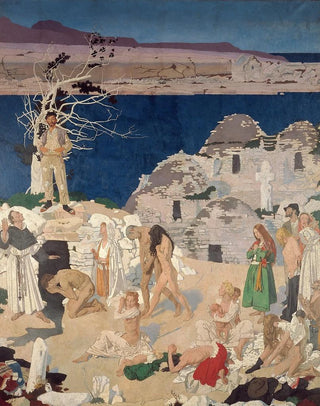Art print | The Sacred Well - William Orpen


View from behind

Frame (optional)
In the fascinating universe of art, some works transcend the simple frame of the canvas to become windows into forgotten worlds. "The Sacred Well" by William Orpen is one of those creations that capture the imagination and invite reflection. Painted in the early 20th century, this piece not only demonstrates the undeniable talent of the artist but also reflects an era marked by social and cultural upheavals. Through this art print, the viewer is transported to a space where the intimate and the sacred meet, revealing the depths of the human soul.
Style and uniqueness of the work
Orpen, with his distinctive style, manages to blend realism with an almost romantic sensitivity. "The Sacred Well" stands out for its bold use of light and shadow, creating a striking contrast that immediately draws the eye. The colors, both vivid and delicate, evoke a mystical atmosphere, as if the painting itself were imbued with palpable spirituality. The composition, although traditional in structure, proves to be dynamic thanks to the way the elements are arranged. Every detail, from the faces of the characters to the textures of the clothing, is carefully rendered, demonstrating Orpen's meticulous attention to reality. This painting does not merely depict a scene; it tells a story, a quest for meaning that still resonates today.
The artist and his influence
William Orpen, an emblematic figure of British art, knew how to establish himself through his unique approach and his commitment to representing human truth. Trained at the Dublin Metropolitan School of Art, he developed a style that combines tradition and modernity. His work is often marked by a profound exploration of themes such as war, memory, and identity—concerns that find echo in "The Sacred Well." Orpen also had a significant influence on his contemporaries, notably through his ability to capture the essence of his era while maintaining a timeless dimension. His artistic legacy endures, inspiring new generations of artists to explore the complexities of human experience through their own

Matte finish

View from behind

Frame (optional)
In the fascinating universe of art, some works transcend the simple frame of the canvas to become windows into forgotten worlds. "The Sacred Well" by William Orpen is one of those creations that capture the imagination and invite reflection. Painted in the early 20th century, this piece not only demonstrates the undeniable talent of the artist but also reflects an era marked by social and cultural upheavals. Through this art print, the viewer is transported to a space where the intimate and the sacred meet, revealing the depths of the human soul.
Style and uniqueness of the work
Orpen, with his distinctive style, manages to blend realism with an almost romantic sensitivity. "The Sacred Well" stands out for its bold use of light and shadow, creating a striking contrast that immediately draws the eye. The colors, both vivid and delicate, evoke a mystical atmosphere, as if the painting itself were imbued with palpable spirituality. The composition, although traditional in structure, proves to be dynamic thanks to the way the elements are arranged. Every detail, from the faces of the characters to the textures of the clothing, is carefully rendered, demonstrating Orpen's meticulous attention to reality. This painting does not merely depict a scene; it tells a story, a quest for meaning that still resonates today.
The artist and his influence
William Orpen, an emblematic figure of British art, knew how to establish himself through his unique approach and his commitment to representing human truth. Trained at the Dublin Metropolitan School of Art, he developed a style that combines tradition and modernity. His work is often marked by a profound exploration of themes such as war, memory, and identity—concerns that find echo in "The Sacred Well." Orpen also had a significant influence on his contemporaries, notably through his ability to capture the essence of his era while maintaining a timeless dimension. His artistic legacy endures, inspiring new generations of artists to explore the complexities of human experience through their own






